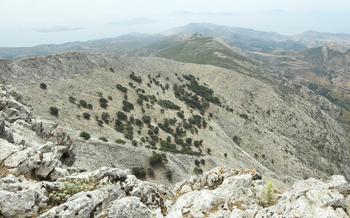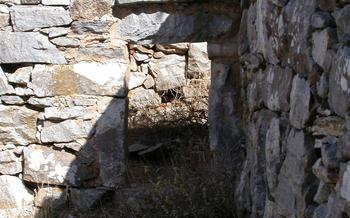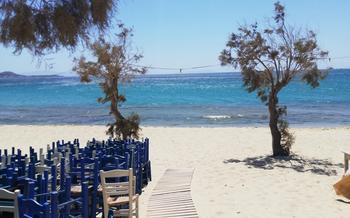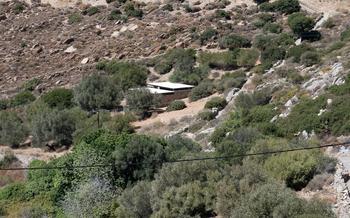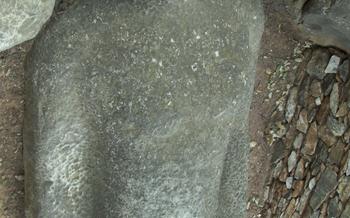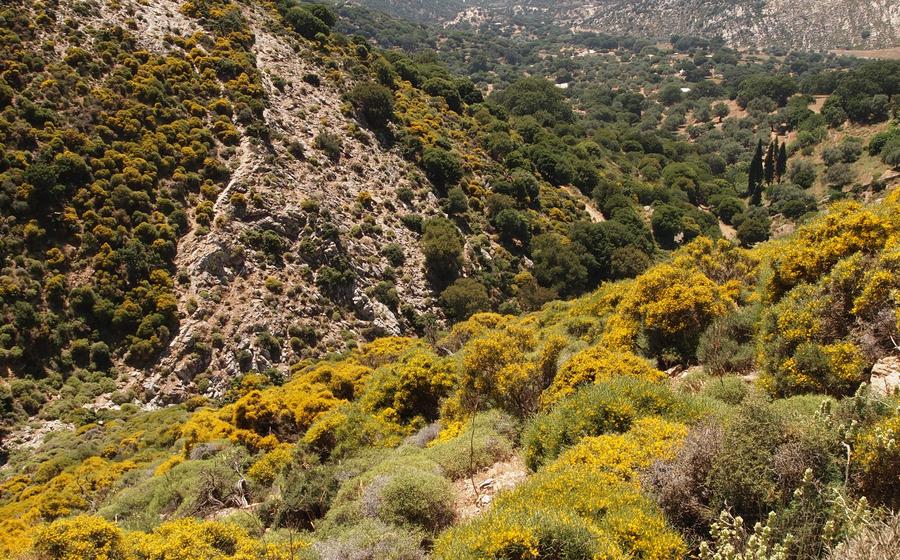
The Cave of Zeus (Zas Cave)
- The Cave of Zeus (Zas Cave): A Mythical Destination
- Exploring the Cave: A Journey Through Time
- Naxos: A Treasure Trove of Natural Wonders
- The Charm of Naxian Villages
- The Archaeological Museum of Naxos
- The Temple of Demeter: A Sacred Sanctuary
- Location and History
- Architectural Features
- Rituals and Ceremonies
- Mythological Connections
- Naxos Castle: A Medieval Masterpiece
- Beaches of Naxos: Paradise Awaits
- Naxian Cuisine: A Culinary Delight
- Hiking in Naxos: Exploring the Island's Trails
- Conquering Mount Zas
- Trekking from Filoti to Apeiranthos
- Following the Venetian Trail
- Discovering Lesser-Known Trails
- Water Sports in Naxos: Thrills on the Waves
- Naxos Town: The Heart of the Island
- Getting to Naxos: A Seamless Journey
- Insider Tip: Discovering Hidden Gems
The Cave of Zeus (Zas Cave): A Mythical Destination
Immerse yourself in ancient mythology and natural wonders at the Cave of Zeus, also known as Zas Cave, on the enchanting island of Naxos. Steeped in captivating legends, this cave is believed to be the birthplace of Zeus, the king of the Greek gods, according to ancient mythology. Nestled on the slopes of Mount Zas, the highest peak of Naxos, the cave beckons adventurers and history enthusiasts alike. Formed by the relentless forces of water erosion and tectonic activity, this natural wonder is a testament to the Earth's enduring power. Reaching the cave requires a scenic hike through the island's captivating landscapes, offering a unique opportunity to connect with nature and delve into the realm of Greek mythology.
Exploring the Cave: A Journey Through Time
The Cave of Zeus, also known as Zas Cave, offers a captivating journey through its chambers and natural sculptures. Guided tours are available, providing insightful commentary on the cave's history and geology. Visitors can explore the cave's main chamber, known as the "Hall of Zeus," where stalactites and stalagmites create an awe-inspiring spectacle. The cave also features numerous smaller chambers, each with its unique formations and hidden corners.
Archaeological excavations within the cave have uncovered pottery shards and other artifacts, suggesting its use as a religious site in ancient times. Visitors can immerse themselves in the legends and rituals associated with the cave, as it was believed to be the birthplace of Zeus, the king of the gods in Greek mythology. The cave's atmosphere and acoustics contribute to its mystical aura, making it a place where ancient myths and natural wonders intertwine.
Naxos: A Treasure Trove of Natural Wonders
Geographic Diversity:
Naxos is blessed with an extraordinary geographic diversity, offering a range of landscapes that captivate and inspire. From the towering peaks of Mount Zas, the highest mountain in the Cyclades, to the lush valleys and pristine beaches, Naxos presents a harmonious contrast of natural elements. Discover hidden coves and secluded bays, where the crystal-clear waters meet the golden shores, inviting you to bask in the Mediterranean sun. The island's unique geological formations, including impressive caves and dramatic gorges, add to its allure, making it a paradise for nature enthusiasts and adventure seekers.
Hiking Trails:
Naxos is a hiker's paradise, boasting an extensive network of well-marked trails that traverse the island's diverse terrain. Whether you're a seasoned trekker or a casual walker, there's a trail to suit your abilities and interests. Conquer the challenging ascent to Mount Zas and be rewarded with breathtaking panoramic views of the island and the surrounding Aegean Sea. Embark on the scenic Filoti to Apeiranthos trail, which winds through traditional villages and offers glimpses into the island's rich cultural heritage. For a historical adventure, follow the Venetian Trail, an ancient path connecting Naxos Town to the Venetian Castle, offering a unique perspective on the island's past.
Beaches:
With over 100 kilometers of coastline, Naxos is a haven for beach lovers. Indulge in the golden sands and crystal-clear waters of Agios Prokopios, one of the island's most popular beaches. Explore Plaka Beach, the longest beach on Naxos, renowned for its water sports facilities and vibrant atmosphere. Discover the hidden gem of Mikri Vigla, where sand dunes and cedar trees create a picture-perfect setting. Uncover secluded coves and pristine beaches along the Naxos coastline, each offering its own unique charm and tranquility. Whether you seek relaxation, adventure, or a combination of both, Naxos' beaches cater to every desire.
The Charm of Naxian Villages
Beyond the bustling beaches and ancient ruins, the island of Naxos is home to a collection of charming villages that offer a glimpse into the authentic Greek way of life. Here, you can wander through narrow cobbled streets, admire traditional whitewashed houses adorned with colorful flowers, and experience the warm hospitality of the locals.
One of the most popular villages is Apeiranthos, located in the mountainous interior of Naxos. With its unique architecture, featuring marble-paved streets and Venetian-style towers, Apeiranthos exudes an old-world charm. Stroll through its picturesque alleys, visit the local museums, and savor traditional Greek cuisine at one of the many tavernas.
Another village worth exploring is Halki, situated on the eastern coast of the island. Known for its lush vegetation and natural springs, Halki is a haven of tranquility. Visit the 18th-century church of Agios Nikolaos, relax by the river, and enjoy a leisurely walk through the surrounding countryside.
Filoti, located in the center of Naxos, is another charming village that offers a taste of traditional Greek life. Explore its narrow streets, visit the local pottery workshops, and indulge in the delicious local cuisine at one of the many family-run tavernas.
In these villages, you'll have the opportunity to interact with the friendly locals, learn about their customs and traditions, and experience the true essence of Naxian culture. Whether you're looking for a peaceful retreat or an authentic Greek experience, Naxos' charming villages are sure to captivate your heart.
The Archaeological Museum of Naxos
Situated in the heart of Naxos Town, the Archaeological Museum is a treasure trove of artifacts that narrate the rich history of the island. Founded in 1973, the museum houses an impressive collection of ancient sculptures, pottery, and artifacts excavated from various sites on Naxos, providing a glimpse into the island's past.
Among the highlights of the collection is the iconic Kouros of Naxos, a colossal marble statue dating back to the 6th century BC. Standing over 10 feet tall, the unfinished kouros (youth) is a testament to the skill and artistry of ancient Naxian sculptors. The museum also features a collection of Cycladic figurines, pottery from the Geometric and Archaic periods, and inscriptions that shed light on the island's political and religious life.
For history enthusiasts, a visit to the Archaeological Museum of Naxos is a must. The museum offers guided tours that provide insights into the significance of the artifacts and the history of Naxos. It's an opportunity to delve deeper into the island's rich cultural heritage and gain a deeper appreciation for its ancient roots.
The Temple of Demeter: A Sacred Sanctuary
Location and History
Perched on a hilltop overlooking the fertile plains of Naxos, the Temple of Demeter stands as a testament to the island's rich history and religious significance. Dedicated to the goddess Demeter, the temple dates back to the 6th century BC and is considered one of the most important archaeological sites on the island.
Architectural Features
The Temple of Demeter is a marvel of ancient Greek architecture, showcasing the distinctive Doric style. Constructed from local marble, the temple features a rectangular layout with a colonnade of Doric columns surrounding the cella, where the cult statue of Demeter once stood. The temple's well-preserved ruins offer a glimpse into the grandeur and artistry of ancient Greek architecture.
Rituals and Ceremonies
The Temple of Demeter was a sacred site where ancient Greeks performed religious rituals and ceremonies in honor of the goddess. Demeter, the goddess of agriculture and fertility, was revered for her role in ensuring bountiful harvests and protecting the land. The temple served as a place for offerings, prayers, and festivals, where the community gathered to celebrate and honor Demeter's divine power.
Mythological Connections
Naxos holds a special place in Greek mythology as the birthplace of the god Dionysus, the son of Zeus and Semele. According to legend, Demeter arrived on Naxos in search of her daughter Persephone, who had been abducted by Hades, the god of the underworld. During her stay on the island, Demeter taught the Naxians the art of agriculture and viticulture, transforming the island into a fertile paradise.
Naxos Castle: A Medieval Masterpiece
Naxos Castle, a majestic fortress standing proudly on a hill overlooking Naxos Town, is a testament to the island's rich history and architectural heritage. Built in the 13th century by the Venetian ruling family, the castle served as a defensive stronghold against pirates and invaders. Its imposing walls, towers, and courtyards have withstood the test of time, offering visitors a glimpse into the island's medieval past.
Exploring Naxos Castle is like stepping back in time. Visitors can wander through its narrow cobblestone streets, marveling at the well-preserved Venetian architecture. The castle's fortifications, including its impressive towers and ramparts, provide a glimpse into the defensive strategies of the era. Within the castle walls, visitors can explore courtyards, churches, and other buildings that once served various purposes, from military to residential.
One of the highlights of Naxos Castle is its breathtaking panoramic views. From the castle's ramparts, visitors can enjoy stunning vistas of Naxos Town, the surrounding countryside, and the shimmering Aegean Sea. The views from the castle are particularly captivating at sunset, when the sky transforms into a canvas of vibrant colors.
Naxos Castle is not just a historical landmark but also a vibrant cultural hub. Throughout the year, the castle hosts a variety of events and exhibitions, including concerts, art shows, and historical reenactments. These events bring the castle to life, allowing visitors to experience its rich heritage in a unique and engaging way.
Beaches of Naxos: Paradise Awaits
Naxos boasts a stunning collection of beaches, each offering a unique experience for visitors. Whether you seek golden sands, crystal-clear waters, or secluded coves, Naxos has a beach to suit every taste.
Agios Prokopios: This popular beach, located just a short distance from Naxos Town, is renowned for its golden sands, shallow waters, and picturesque views. Ideal for families and those seeking relaxation, Agios Prokopios offers a range of amenities, including sunbeds, umbrellas, and water sports facilities.
Plaka Beach: Known for its impressive length, Plaka Beach stretches for several kilometers along the west coast of Naxos. This vibrant beach offers a variety of water sports activities, including windsurfing, kitesurfing, and paddleboarding. With its lively atmosphere and numerous beach bars and restaurants, Plaka Beach is a popular spot for both locals and tourists.
Mikri Vigla: Located on the southern tip of Naxos, Mikri Vigla Beach is a true hidden gem. This unspoiled beach boasts unique sand dunes, crystal-clear waters, and a backdrop of cedar trees. While the beach is relatively small, its secluded location and stunning scenery make it a favorite among those seeking tranquility and natural beauty.
Beyond these popular beaches, Naxos offers a wealth of other beautiful coastal spots to explore. From the secluded coves of Kastraki and Glyfada to the picturesque Lionas Beach, there is a beach for every preference on this diverse island. Whether you prefer swimming, sunbathing, or simply enjoying the stunning views, Naxos' beaches are sure to captivate and delight.
Naxian Cuisine: A Culinary Delight
Naxos is not only a feast for the eyes but also for the taste buds. The island's cuisine is a harmonious blend of fresh, local ingredients and traditional recipes, passed down through generations. Savor the flavors of Naxian potatoes, a signature dish made with tender potatoes slow-cooked in a rich tomato sauce, herbs, and spices. Xinomizithra cheese, a local specialty, is a tangy, creamy cheese made from sheep or goat's milk, perfect for adding a unique flavor to salads, pasta, or pastries. And don't forget to try Kitron, a refreshing liqueur made from the aromatic citron fruit, grown exclusively on Naxos.
Visit local tavernas to indulge in freshly caught seafood, grilled to perfection and seasoned with olive oil, lemon, and herbs. Sample local products such as honey, renowned for its rich flavor and aroma, and Naxian cheese, made from sheep or goat's milk, offering a variety of textures and tastes. Naxos also boasts a thriving wine industry, with local wineries producing excellent white and red wines that pair perfectly with the island's cuisine. Whether you're dining at a traditional taverna, enjoying a picnic on the beach, or taking a cooking class to learn the secrets of Naxian cuisine, you'll be in for a culinary adventure that will leave you craving for more.
Hiking in Naxos: Exploring the Island's Trails
Naxos offers a diverse range of hiking trails that cater to all levels of hikers, from leisurely walks to challenging mountain ascents. Whether you're seeking panoramic views, historical paths, or hidden gems, Naxos has something for every outdoor enthusiast.
Conquering Mount Zas
The most iconic hike on Naxos is the ascent to Mount Zas, the highest peak in the Cyclades. The trail begins from the village of Filoti and takes you through a variety of landscapes, including forests, meadows, and rocky terrain. The summit rewards you with breathtaking views of the entire island, the surrounding sea, and neighboring islands.
Trekking from Filoti to Apeiranthos
Another popular hike connects the villages of Filoti and Apeiranthos, two of the most picturesque villages on Naxos. The trail winds through traditional villages, olive groves, and stunning landscapes, offering a glimpse into the island's rich history and culture.
Following the Venetian Trail
History buffs will appreciate the Venetian Trail, an ancient path that once connected Naxos Town to the Venetian Castle. The trail takes you through historical sites, such as the abandoned village of Potamia, and offers panoramic views of the surrounding countryside.
Discovering Lesser-Known Trails
Beyond these well-known trails, Naxos offers a network of lesser-known paths that lead to hidden gems and secluded spots. Explore the trails that wind through the cedars of Mikri Vigla, climb to the top of Profitis Ilias hill for stunning sunset views, or venture into the lush valleys of Tragea.
Whether you're a seasoned hiker or a casual walker, Naxos' trails offer something for everyone. Lace up your hiking boots and prepare to explore the island's natural beauty and rich history on foot.
Water Sports in Naxos: Thrills on the Waves
Naxos offers an array of water sports activities that cater to every level of adventure seeker. The island is a renowned destination for windsurfing and kitesurfing enthusiasts, with the Meltemi winds providing ideal conditions for harnessing the power of the waves. Popular spots for these exhilarating sports include Mikri Vigla, with its shallow waters and consistent winds, and Plaka Beach, offering a variety of windsurfing schools and rental shops.
Surfers can catch waves at beginner-friendly beaches like Agios Georgios, known for its gentle waves and sandy bottom. Experienced surfers may venture to the south coast of the island, where they'll find more challenging waves and fewer crowds.
For those who prefer to explore the underwater world, Naxos offers a variety of scuba diving and snorkeling sites. The crystal-clear waters provide excellent visibility, allowing divers to admire the diverse marine life, including colorful fish, sea turtles, and even shipwrecks. Snorkeling is also a great way to discover the underwater beauty of Naxos, with many shallow and sheltered coves providing easy access to the marine life.
Other water sports activities available on the island include sailing, kayaking, and stand-up paddleboarding. These activities offer a unique perspective of the island's stunning coastline and provide a relaxing way to explore the hidden coves and beaches. Whether you're a seasoned water sports enthusiast or trying something new, Naxos has something to offer everyone.
Naxos Town: The Heart of the Island
Naxos Town, the vibrant capital of Naxos, is a captivating blend of history, culture, and picturesque charm. As you approach the island, the iconic Portara, a monumental marble gateway, stands proudly on Palatia islet, welcoming you to this enchanting destination.
Strolling through the narrow, winding streets of the Old Town is like stepping back in time. Admire the whitewashed houses with their colorful doors and balconies adorned with flowers, creating a vibrant streetscape. Discover charming boutiques, traditional tavernas, and local shops showcasing handmade crafts and local delicacies.
At the heart of Naxos Town lies the Archaeological Museum, a treasure trove of artifacts that narrate the island's rich history and culture. Explore exhibits showcasing ancient sculptures, pottery, and relics that provide a glimpse into Naxos's past.
As the sun sets, the town transforms into a lively hub of activity. Indulge in the vibrant nightlife scene, with bars, clubs, and traditional tavernas offering a variety of entertainment options. Sample the local cuisine, savor fresh seafood dishes, and enjoy the warm hospitality of the Naxian people.
Whether you're seeking historical charm, cultural experiences, or a vibrant atmosphere, Naxos Town has something to offer every traveler. Immerse yourself in the heart of Naxian life and create lasting memories in this captivating island capital.
Getting to Naxos: A Seamless Journey
Reaching Naxos is a breeze, with several transportation options available. The most popular mode of transport is by ferry, which departs frequently from Athens (Piraeus) and other nearby islands like Paros and Mykonos. The journey takes approximately 4-5 hours and offers stunning views of the Aegean Sea.
For those seeking a quicker option, flying to Naxos Island National Airport is a convenient choice. Direct flights operate from Athens and other major Greek cities, taking around 45 minutes. Once on the island, various transportation options are available, including buses, taxis, and rental cars, to explore its diverse landscapes and attractions.
If you're planning an island-hopping adventure, incorporating Naxos into your itinerary is a must. The island's central location in the Cyclades makes it an ideal starting point or stopover for exploring other popular destinations like Santorini, Mykonos, and Paros. Ferries connect Naxos to these islands, providing a seamless and enjoyable way to experience the beauty and diversity of the Cyclades.
To make the most of your Naxos trip, planning and booking your tickets in advance is recommended. Check ferry schedules, compare prices, and consider booking online to secure your spot, especially during peak tourist season. With its easy accessibility and convenient transportation options, getting to Naxos is a breeze, setting the stage for an unforgettable Greek island adventure.
Insider Tip: Discovering Hidden Gems
Naxos offers a plethora of hidden gems waiting to be discovered by the adventurous traveler. Venture off the beaten path to uncover secluded beaches, traditional villages, and unique experiences that will leave you with lasting memories.
Explore pristine beaches like Kastraki, Glyfada, and Lionas, where you can bask in the sun, swim in crystal-clear waters, and escape the crowds. Immerse yourself in the authentic Greek way of life by visiting traditional villages like Koronos and Eggares, where time seems to stand still. Stroll through narrow streets, admire whitewashed houses adorned with colorful flowers, and engage with friendly locals who are always eager to share stories about their culture.
To fully immerse yourself in the Naxian experience, participate in local festivals and events that celebrate the island's rich traditions. The Grape Festival in September is a highlight, offering a chance to witness traditional grape stomping, taste local wines, and indulge in delicious local cuisine. Embrace the vibrant energy of these events and connect with the warm hospitality of the Naxian people.
